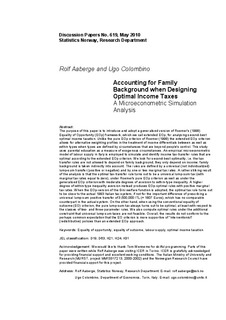| dc.contributor.author | Aaberge, Rolf | |
| dc.contributor.author | Colombino, Ugo | |
| dc.date.accessioned | 2010-10-19T09:47:49Z | |
| dc.date.available | 2010-10-19T09:47:49Z | |
| dc.date.issued | 2010 | |
| dc.identifier.issn | 0809-733X | |
| dc.identifier.uri | http://hdl.handle.net/11250/179989 | |
| dc.description | Discussion papers (Statistisk sentralbyrå, Forskningsavdelingen) er også tilgjengelige via www.ssb.no | en_US |
| dc.description.abstract | Abstract:
The purpose of this paper is to introduce and adopt a generalised version of Roemer's (1998) Equality of Opportunity (EOp) framework, which we call extended EOp, for analysing second-best optimal income taxation. Unlike the pure EOp criterion of Roemer (1998) the extended EOp criterion allows for alternative weighting profiles in the treatment of income differentials between as well as within types when types are defined by circumstances that are beyond people's control. This study uses parental education as a measure of exogenous circumstances. An empirical microeconometric model of labour supply in Italy is employed to simulate and identify income tax-transfer rules that are optimal according to the extended EOp criterion. We look for second-best optimality, i.e. the tax-transfer rules are not allowed to depend on family background, they only depend on income: family background is taken indirectly into account. The rules are defined by a universal (not individualized) lump-sum transfer (positive or negative) and by one or two marginal tax rates. A rather striking result of the analysis is that the optimal tax-transfer rule turns out to be a universal lump-sum tax (with marginal tax rates equal to zero), under Roemer's pure EOp criterion as well as under the generalised EOp criterion with moderate degrees of aversion to within-type inequality. A higher degree of within-type inequality aversion instead produces EOp-optimal rules with positive marginal tax rates. When the EOp-version of the Gini welfare function is adopted, the optimal tax rule turns out to be close to the actual 1993 Italian tax system, if not for the important difference of prescribing a universal lump-sum positive transfer of 3,500,000 ITL (= 1807 Euros), which has no comparable counterpart in the actual system. On the other hand, when using the conventional equality of outcome (EO) criterion, the pure lump-sum tax always turns out to be optimal, at least with respect to the classes of two- and three-parameter rules. We also compute optimal rules under the additional constraint that universal lump-sum taxes are not feasible. Overall, the results do not conform to the perhaps common expectation that the EO criterion is more supportive of “interventionist” (redistributive) policies than an extended EOp approach.
KEYWORDS: Equality of opportunity, equality of outcome, labour supply, optimal income taxation | en_US |
| dc.language.iso | eng | en_US |
| dc.publisher | Statistics Norway, Research Department | en_US |
| dc.relation.ispartofseries | Discussion Papers;No. 619 | |
| dc.relation.uri | http://www.ssb.no/cgi-bin/publsoek?job=forside&id=dp-619&kode=dp&lang=en | |
| dc.subject | Equality of opportunity | en_US |
| dc.subject | Equality of outcome | en_US |
| dc.subject | Labour supply | en_US |
| dc.subject | Income taxation | en_US |
| dc.subject | JEL classification: D19 | en_US |
| dc.subject | JEL classification: D63 | en_US |
| dc.subject | JEL classification: H21 | en_US |
| dc.subject | JEL classification: H24 | en_US |
| dc.subject | JEL classification: H31 | en_US |
| dc.subject | Inntektsskatt | en_US |
| dc.title | Accounting for family background when designing optimal income taxes : a microeconometric simulation analysis | en_US |
| dc.type | Working paper | en_US |
| dc.subject.nsi | VDP::Social science: 200::Economics: 210::Econometrics: 214 | en_US |
| dc.subject.nsi | VDP::Mathematics and natural science: 400::Mathematics: 410::Statistics: 412 | en_US |
| dc.source.pagenumber | 38 s. | en_US |
